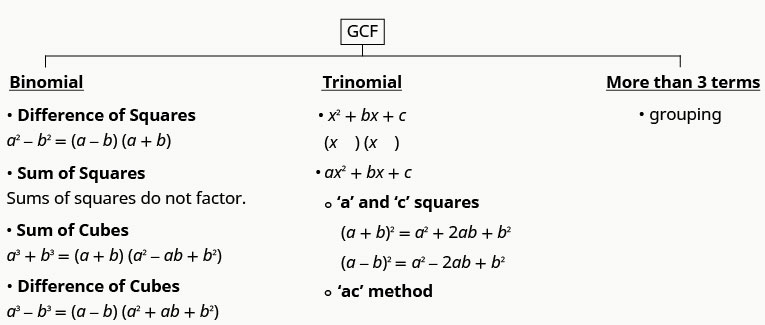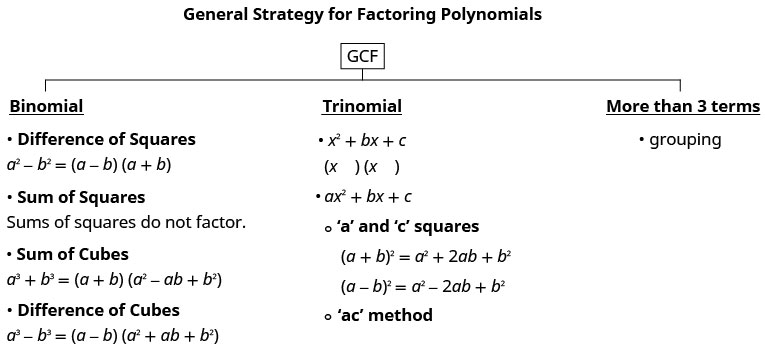1.2.9: General Strategy for Factoring Polynomials
- Page ID
- 93972
By the end of this section, you will be able to:
- Recognize and use the appropriate method to factor a polynomial completely
Before you get started, take this readiness quiz.
1. Find the GCF of \(2x^4-14x^3-4x^2\).
2. Find the product \((3y+4)(3y-4)\).
3. Find the coefficient of \(x\) in \((2x-7)(3x+3)\).
Recognizing and Using the Appropriate Method to Factor a Polynomial Completely
You have now become acquainted with all the methods of factoring that you will need in this course. The following chart summarizes all the factoring methods we have covered, and outlines a strategy you should use when factoring polynomials.
General Strategy for Factoring Polynomials
This chart shows the general strategies for factoring polynomials. It shows ways to find GCF of binomials, trinomials and polynomials with more than 3 terms. For binomials, we have difference of squares: a squared minus \(b\) squared equals a minus \(b\), \(a\) plus \(b\); sum of squares do not factor; sub of cubes: \(a\) cubed plus \(b\) cubed equals open parentheses \(a\) plus \(b\) close parentheses open parentheses a squared minus \(ab\) plus \(b\) squared close parentheses; difference of cubes: \(a\) cubed minus \(b\) cubed equals open parentheses \(a\) minus \(b\) close parentheses open parentheses a squared plus \(ab\) plus \(b\) squared close parentheses. For trinomials, we have \(x\) squared plus \(bx\) plus \(c\) where we put \(x\) as a term in each factor and we have a squared plus \(bx\) plus \(c\). Here, if \(a\) and \(c\) are squares, we have \(a\) plus \(b\) whole squared equals a squared plus \(2 ab\) plus \(b\) squared and \(a\) minus \(b\) whole squared equals a squared minus \(2 ab\) plus \(b\) squared. If \(a\) and \(c\) are not squares, we use the "ac" method. For polynomials with more than 3 terms, we use grouping.
General Strategy for Factoring Polynomials
- What is the greatest common factor?
Factor it out if it is not \(1\). - Is the polynomial a binomial, trinomial, or are there more than three terms?
If it is a binomial:- Is it a sum?
Of squares? Sums of squares do not factor.
Of cubes? Use the sum of cubes pattern. - Is it a difference?
Of squares? Factor as the product of conjugates.
Of cubes? Use the difference of cubes pattern.
- Is it of the form \(x^2+bx+c\)? Undo FOIL.
- Is it of the form \(ax^2+bx+c\)?
If a and c are squares, check if it fits the trinomial square pattern.
Use the trial and error or “\(ac\)” method.
- Use the grouping method.
- Is it a sum?
- Check.
Is it factored completely?
Do the factors multiply back to the original polynomial?
Remember, a polynomial is completely factored if, other than monomials, its factors are prime!
Factor \(7x^3−21x^2−70x\).
Solution
| \(\quad 7x^3−21x^2−70x\) | |
|
What is the GCF? \(7x\). Factor out the GCF. |
\(=7x(x^2−3x−10)\) |
|
In the parentheses, is it a binomial, trinomial, or are there more terms Trinomial with leading coefficient 1. |
\(=7x(x+2)(x−5)\) |
| Is the expression factored completely? Yes, neither binomial can be factored. | |
| Check your answer. |
Multiply. \(\begin{align*} &7x(x+2)(x−5) \\ = & 7x(x^2−5x+2x−10)\\ = & 7x^3−21x^2−70x \quad\checkmark\end{align*}\) |
| Conclude. | The factorization of \(7x^3-21x^2-70x\) is \(7x(x+2)(x-5)\). |
Try It \(\PageIndex{2}\)
Factor \(8y^3+16y^2−24y\).
- Answer
-
\(8y(y−1)(y+3)\)
Try It \(\PageIndex{3}\)
Factor \(5y^3−15y^2−270y\).
- Answer
-
\(5y(y−9)(y+6)\)
Be careful when you are asked to factor a binomial as there are several options!
Factor \(24y^2−150\).
Solution
| \(\quad 24y^2−150\) | |
|
What is the GCF? \(6\). Factor out the GCF. |
\(=6(4y^2−25)\) |
|
In the parentheses, is it a binomial, trinomial or are there more than three terms? Binomial. Is it a difference? Of squares or cubes? Yes, squares. |
\(=6((2y)^2−(5)^2)\) |
| Write as a product of conjugates. | \(=6(2y−5)(2y+5)\) |
| Is the expression factored completely? Yes, neither binomial can be factored. | |
| Check your answer. |
Multiply. \(\begin{align*} & 6(2y−5)(2y+5) \\ =& 6(4y^2−25) \\ =&24y^2−150\quad \checkmark\end{align*}\) |
| Conclude. | The factorization of \(24y^2−150\) is \(6(2y−5)(2y+5)\). |
Try It \(\PageIndex{5}\)
Factor \(16x^3−36x\).
- Answer
-
\(4x(2x−3)(2x+3)\)
Try It \(\PageIndex{6}\)
Factor \(27y^2−48\).
- Answer
-
\(3(3y−4)(3y+4)\)
The next example can be factored using several methods. Recognizing the trinomial squares pattern will make your work easier.
Factor \(4a^2−12ab+9b^2\).
Solution
| \(\quad 4a^2−12ab+9b^2\) | |
|
What is the GCF? \(1\). Is it a binomial, trinomial, or are there more terms?Trinomial with \(a\neq 1\) The first term is a perfect square. Is the last term a perfect square? Yes. |
\(=(2a)^2−12ab+(3b)^2\) |
| Does it fit the pattern \(a^2−2ab+b^2\)? Yes | \(=(2a)^2 −2(2a)(3b)+ (3b)^2\) |
| Write it as a square. | \(=(2a−3b)^2\) |
| Is the expression factored completely? Yes. The binomial cannot be factored. | |
| Check your answer. |
Multiply. \begin{align*} & (2a−3b)^2 \\ = & (2a)^2−2(2a)(3b)+(3b)^2 \\=&4a^2−12ab+9b^2\quad \checkmark \end{align*} |
| Conclude. | The factorization of \(4a^2−12ab+9b^2\) is \((2a−3b)^2\). |
Try It \(\PageIndex{8}\)
Factor \(4x^2+20xy+25y^2\).
- Answer
-
\((2x+5y)^2\)
Try It \(\PageIndex{9}\)
Factor \(9x^2−24xy+16y^2\).
- Answer
-
\((3x−4y)^2\)
Remember, sums of squares do not factor, but sums of cubes do!
Factor \(12x^3y^2+75xy^2\).
Solution
| \(\quad 12x^3y^2+75xy^2\) | |
|
What is the GCF? \(3xy^2\). Factor out the GCF. |
\(=3xy^2(4x^2+25)\) |
|
In the parentheses, is it a binomial, trinomial, or are there more than three terms? Binomial. Is it a sum? Of squares? Yes. Sums of squares are prime. Is the expression factored completely? Yes. |
|
| Check. |
Multiply. \(\quad 3xy^2(4x^2+25) \) \(=12x^3y^2+75xy^2\quad \checkmark\) |
| Conclude. | The factorization of \(12x^3y^2+75xy^2\) is \(3xy^2(4x^2+25)\). |
Try It \(\PageIndex{11}\)
Factor \(50x^3y+72xy\).
- Answer
-
\(2xy(25x^2+36)\)
Try It \(\PageIndex{12}\)
Factor \(27xy^3+48xy\).
- Answer
-
\(3xy(9y^2+16)\)
When using the sum or difference of cubes pattern, being careful with the signs.
Factor \(24x^3+81y^3\).
Solution
| \(\quad 24x^3+81y^3\) | |
|
What is the GCF? \(3\). Factor it out. |
\(=3(8x^3+27y^3)\) |
|
In the parentheses, is it a binomial, trinomial, Of squares or cubes? Sum of cubes. |
\(=3((2x)^3+(3y)^3) |
|
Write it using the sum of cubes pattern. \(a^3+b^3 = (a+b)(a^2-ab+b^2)\) |
\(=3(2x+3y)((2x)^2-2x\cdot 3y +(3y)^2)\) |
| Is the expression factored completely? Yes. |
\(=3(2x+3y)(4x^2-6xy+9y^2)\) |
| Check by multiplying. | |
| Conclude. | The factorization of \(24x^3+81y^3\) is \(3(2x+3y)(4x^2-6xy+9y^2\). |
Try It \(\PageIndex{14}\)
Factor \(250m^3+432n^3\).
- Answer
-
\(2(5m+6n)(25m^2−30mn+36n^2)\)
Try It \(\PageIndex{15}\)
Factor \(2p^3+54q^3\).
- Answer
-
\(2(p+3q)(p^2−3pq+9q^2)\)
Example \(\PageIndex{16}\)
Factor \(3x^5y−48xy\).
- Solution
-
\(\begin{array} {ll} &3x^5y−48xy \\ \text{Is there a GCF? Factor out }3xy &3xy(x^4−16) \\ \begin{array} {l} \text{Is the binomial a sum or difference? Of squares or cubes?} \\ \text{Write it as a difference of squares.} \end{array} &3xy\left((x^2)^2−(4)2\right) \\ \text{Factor it as a product of conjugates} &3xy(x^2−4)(x^2+4) \\ \text{The first binomial is again a difference of squares.} &3xy\left((x)^2−(2)^2\right)(x^2+4) \\ \text{Factor it as a product of conjugates.} &3xy(x−2)(x+2)(x^2+4) \\ \text{Is the expression factored completely? Yes.} & \\ \text{Check your answer.} & \\ \text{Multiply.} & \\ 3xy(x−2)(x+2)(x^2+4) & \\ 3xy(x^2−4)(x^2+4) & \\ 3xy(x^4−16) & \\ 3x^5y−48xy\checkmark & \end{array}\)
Try It \(\PageIndex{17}\)
Factor \(4a^5b−64ab\).
- Answer
-
\(4ab(a^2+4)(a−2)(a+2)\)
Try It \(\PageIndex{18}\)
Factor \(7xy^5−7xy\).
- Answer
-
\(7xy(y^2+1)(y−1)(y+1)\)
Example \(\PageIndex{19}\)
Factor \(4x^2+8bx−4ax−8ab\).
- Solution
-
\(\begin{array} {ll} &4x^2+8bx−4ax−8ab \\ \text{Is there a GCF? Factor out the GCF, }4. &4(x^2+2bx−ax−2ab) \\ \text{There are four terms. Use grouping.} &4[x(x+2b)−a(x+2b)]4(x+2b)(x−a) \\ \text{Is the expression factored completely? Yes.} & \\ \text{Check your answer.} & \\ \text{Multiply.} & \\ \hspace{25mm}4(x+2b)(x−a) & \\ \hspace{20mm} 4(x^2−ax+2bx−2ab) & \\ \hspace{20mm}4x^2+8bx−4ax−8ab\checkmark \end{array}\)
Try It \(\PageIndex{20}\)
Factor \(6x^2−12xc+6bx−12bc\).
- Answer
-
\(6(x+b)(x−2c)\)
Try It \(\PageIndex{21}\)
Factor \(16x^2+24xy−4x−6y\).
- Answer
-
\(2(4x−1)(2x+3y)\)
Taking out the complete GCF in the first step will always make your work easier.
Factor \(40x^2y+44xy−24y\).
Solution
\(\begin{array} {ll} &40x^2y+44xy−24y \\ \text{Is there a GCF? Factor out the GCF, }4y. &4y(10x^2+11x−6) \\ \text{Factor the trinomial with }a\neq 1. &4y(10x^2+11x−6) \\ &4y(5x−2)(2x+3) \\ \text{Is the expression factored completely? Yes.} & \\ \text{Check your answer.} & \\ \text{Multiply.} & \\ \hspace{25mm}4y(5x−2)(2x+3) & \\ \hspace{24mm}4y(10x^2+11x−6) & \\ \hspace{22mm}40x^2y+44xy−24y\checkmark \end{array}\)
Try It \(\PageIndex{23}\)
Factor \(4p^2q−16pq+12q\).
- Answer
-
\(4q(p−3)(p−1)\)
Try It \(\PageIndex{24}\)
Factor \(6pq^2−9pq−6p\).
- Answer
-
\(3p(2q+1)(q−2)\)
When we have factored a polynomial with four terms, most often we separated it into two groups of two terms. Remember that we can also separate it into a trinomial and then one term.
Factor \(9x^2−12xy+4y^2−49\).
Solution
| \(\quad 9x^2−12xy+4y^2−49\) | |
|
What is the GCF? \(1\). With more than 3 terms, use grouping. Last 2 terms have GCF equals to 1. Try grouping first 3 terms. Factor the trinomial with \(a\neq 1\). The first term is a perfect square. Is the last term of the trinomial a perfect square? Yes. |
\(=(3x)^2−12xy+(2y)^2−49\) |
| Does the trinomial fit the pattern \(a^2−2ab+b^2\)? Yes. | \(=(3x)^2 −2(3x)(2y)+ (2y)^2−49\) |
| Write the trinomial as a square. | \(=(3x−2y)^2−49\) |
|
Is this binomial a sum or difference of squares or cubes? Yes, a difference of squares. Write it as a difference of squares. |
\(= (3x−2y)^2−7^2\) |
| Write it as a product of conjugates. |
\(=((3x−2y)−7)((3x−2y)+7)\) \(=(3x−2y−7)(3x−2y+7)\) |
|
Is the expression factored completely? Yes. Check your answer. |
Multiply. \(\quad (3x−2y−7)(3x−2y+7)\) \(=9x^2−6xy−21x−6xy+4y^2+14y+21x−14y−49\) \(=9x^2−12xy+4y^2−49\quad \checkmark\) |
| Conclude. | The factorization of \(9x^2−12xy+4y^2−49\) is \((3x−2y−7)(3x−2y+7)\). |
Try It \(\PageIndex{26}\)
Factor \(4x^2−12xy+9y^2−25\).
- Answer
-
\((2x−3y−5)(2x−3y+5)\)
Try It \(\PageIndex{27}\)
Factor \(16x^2−24xy+9y^2−64\).
- Answer
-
\((4x−3y−8)(4x−3y+8)\)
- How do you check that you have factored correctly? Give an example.
- How many binomial factors could a polynomial of degree 5 have? Explain and give an example of the maximum number.
- Why might it be useful to factor?
- Use factoring to carry out the division: \(\dfrac{5x^3-5x^2+30x}{x^2+2x}\)
- If you know that \(2x-5\) is a factor of \(4x^2-4x-15\) help you to factor the latter? Explain.
Key Concepts

- How to use a general strategy for factoring polynomials.
- Is there a greatest common factor?
Factor it out. - Is the polynomial a binomial, trinomial, or are there more than three terms?
If it is a binomial:
Is it a sum?
Of squares? Sums of squares do not factor.
Of cubes? Use the sum of cubes pattern.
Is it a difference?
Of squares? Factor as the product of conjugates.
Of cubes? Use the difference of cubes pattern.
If it is a trinomial:
Is it of the form \(x^2+bx+c\)? Undo FOIL.
Is it of the form \(ax^2+bx+c\)?
If \(a\) and \(c\) are squares, check if it fits the trinomial square pattern.
Use the trial and error or “\(ac\)” method.
If it has more than three terms:
Use the grouping method. - Check.
Is it factored completely?
Do the factors multiply back to the original polynomial?
- Is there a greatest common factor?


